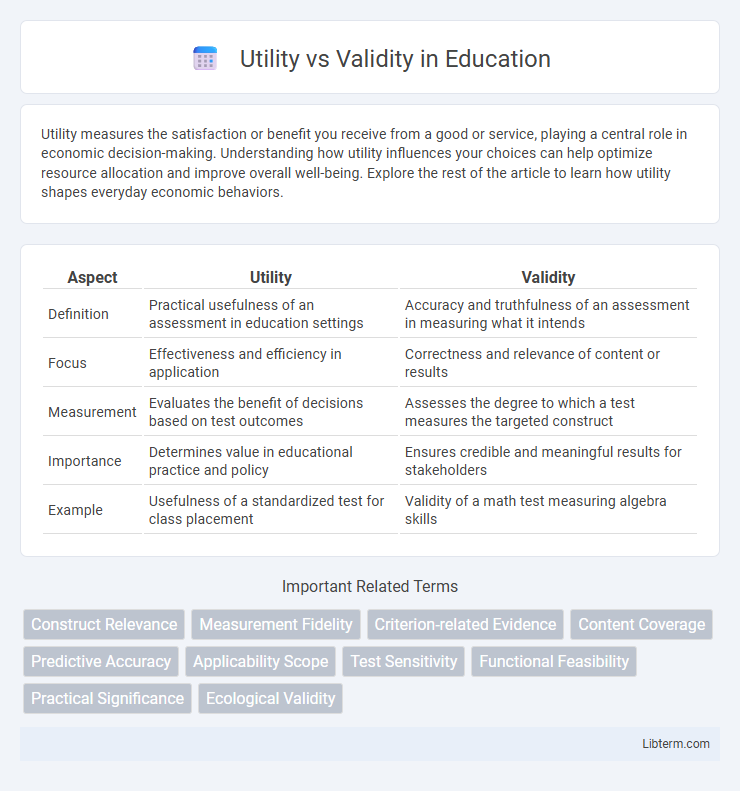Utility measures the satisfaction or benefit you receive from a good or service, playing a central role in economic decision-making. Understanding how utility influences your choices can help optimize resource allocation and improve overall well-being. Explore the rest of the article to learn how utility shapes everyday economic behaviors.
Table of Comparison
| Aspect | Utility | Validity |
|---|---|---|
| Definition | Practical usefulness of an assessment in education settings | Accuracy and truthfulness of an assessment in measuring what it intends |
| Focus | Effectiveness and efficiency in application | Correctness and relevance of content or results |
| Measurement | Evaluates the benefit of decisions based on test outcomes | Assesses the degree to which a test measures the targeted construct |
| Importance | Determines value in educational practice and policy | Ensures credible and meaningful results for stakeholders |
| Example | Usefulness of a standardized test for class placement | Validity of a math test measuring algebra skills |
Introduction: Defining Utility and Validity
Utility refers to the practical usefulness and effectiveness of a tool, method, or process in achieving desired outcomes, while validity measures the accuracy and truthfulness of the results produced. In research and testing, utility emphasizes the applicability and benefits in real-world scenarios, whereas validity ensures that conclusions genuinely reflect the intended constructs or phenomena. Understanding the distinction between utility and validity is crucial for evaluating the overall quality and impact of assessments or interventions.
Core Concepts: What is Utility?
Utility refers to the practical usefulness or applicability of a test, tool, or method in achieving specific goals or solving problems in real-world contexts. It measures how effectively the results can inform decision-making, improve outcomes, or enhance performance across various domains such as education, psychology, or business. High utility indicates that the test or method provides actionable insights that lead to meaningful improvements or benefits.
Core Concepts: What is Validity?
Validity refers to the degree to which a test or measurement accurately measures what it is intended to measure, ensuring the results reflect the true construct under investigation. It is a critical concept in research design, affecting the credibility and applicability of findings across various scientific disciplines. Core types of validity include content validity, construct validity, and criterion-related validity, each addressing different aspects of measurement accuracy.
Key Differences Between Utility and Validity
Utility measures the practical usefulness or applicability of a tool, process, or data, emphasizing how well it meets user needs or achieves desired outcomes. Validity assesses the accuracy and truthfulness of a measurement or concept, ensuring that it truly represents what it claims to measure. Key differences lie in utility focusing on effectiveness and convenience, while validity centers on correctness and reliability of results.
The Role of Utility in Real-World Applications
Utility emphasizes the practical relevance and effectiveness of a tool, test, or method in real-world scenarios, often driving decision-making and problem-solving processes. In applied fields such as psychology, education, and healthcare, high utility ensures that assessments or interventions lead to meaningful, actionable outcomes that improve user experiences or treatment efficacy. Validity supports utility by confirming the accuracy and appropriateness of the tool, but utility remains central in determining the real-world impact and value of the results obtained.
Types of Validity: An Overview
Types of validity encompass construct validity, which measures how well a test or tool assesses the intended concept, and content validity, evaluating the extent to which a measure covers the representative content domain. Criterion-related validity, including predictive and concurrent validity, assesses how well one measure predicts an outcome based on another established measure. Understanding these types of validity is essential for determining the accuracy and relevance of research findings, directly impacting the utility of measurement instruments.
Measuring Utility and Validity
Measuring utility involves evaluating the practical benefits and effectiveness of a tool or method in real-world applications, often quantified through metrics like cost-effectiveness, user satisfaction, or impact on outcomes. Validity measurement assesses the accuracy and truthfulness of an instrument, ensuring it measures what it claims to measure, commonly tested through content, construct, and criterion-related validity. Both utility and validity metrics are essential in determining the overall value and reliability of assessments, influencing decisions in fields such as psychology, education, and healthcare.
Utility vs Validity in Research Design
Utility in research design emphasizes the practical application and relevance of findings to real-world problems, ensuring that results are actionable and beneficial for stakeholders. Validity focuses on the accuracy and credibility of the research, guaranteeing that the study measures what it intends to and that conclusions drawn are trustworthy. Balancing utility and validity is crucial for designing research that is both impactful and scientifically sound, optimizing the effectiveness and reliability of study outcomes.
Balancing Utility and Validity: Best Practices
Balancing utility and validity requires selecting assessment tools that provide actionable insights while maintaining accuracy and reliability in measurement. Employing iterative validation processes, such as pilot testing and feedback loops, helps ensure that tests remain both practical for decision-making and statistically sound. Regularly updating tools based on empirical data and stakeholder needs optimizes the balance between utility and validity in organizational contexts.
Conclusion: Maximizing Both Utility and Validity
Maximizing both utility and validity requires a balanced approach that ensures data is not only accurate but also actionable for decision-making. Leveraging robust validation methods alongside user-centric design enhances the practical application of findings while maintaining integrity. Integrating continuous feedback loops helps refine data relevance, thereby increasing overall effectiveness in real-world scenarios.
Utility Infographic

 libterm.com
libterm.com